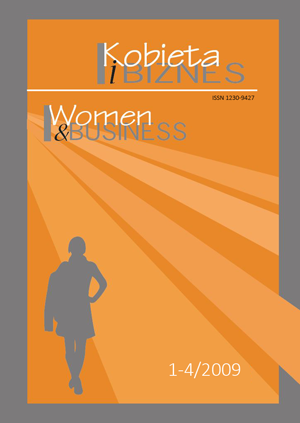Gender diversity in the workplace
Main Article Content
Abstract
Gender diversity is the fact in employment. However, not all companies have introduced equal treatment of women and men as a norm. The mechanisms of controlling and monitoring the situation in the workplace by the state bodies, e.g. Labour Inspectorate, the Offi ce for Equality or the Ministry of Labour are not effective. As yet, the attempts at eliminating discrimination in the area of access to employment and in the place of work have not been successful - there are often cases when female candidates for a job are asked questions concerning their family status, including the number and age of children, as well as questions about organization of childcare when a woman is at work. Therefore, it is much more diffi cult for women to fi nd their fi rst job, they also fi nd leaving unemployment much more diffi cult than men. There are too often observed cases of sexual harassment in the workplace, while the employers pay too little attention to prevention of this negative phenomenon - there is lack of internal training and procedures of action in situation when there are observed cases of sexual harassment. Employed women participate in training and are promoted much less often than men; there is a tendency towards professional segregation and lower pay for women even for work of the same value.There are still many things that should be done regarding solutions facilitating reconciliation between professional responsibilities and private life. Neither the government's actions initiated within the scope of social policy, nor the employers' attempts in this area are suffi cient. Employers prefer male candidates for work, considering them to be more available (fl exible), as they are not burdened with family responsibilities. Working environment ignores the fact that majority of the employed have families and children. Polish employers are only rarely aware of the fact that diversity translates into better fi nancial effects.Therefore, it may be agreed that "Women are the resource most often ignored and unappreciated in business; both as consumers and employees (...) This comprises the greatest weakness of the business model designed in the world dominated by men (...). Necessary is the revolution in the way of thinking". (author's abstract)
Article Details
Authors retain copyright and grant the journal right of first publication with the work simultaneously licensed under a Creative Commons Attribution License that allows others to share the work with an acknowledgement of the work's authorship and initial publication in this journal. All authors agree for publishing their email adresses, affiliations and short bio statements with their articles during the submission process.
Author agrees to share his work under CC-BY-NC license.
References
2. Aktywność ekonomiczna ludności Polski, III kwartał 2008. W: Informacje i Opracowania Statystyczne, GUS, Warszawa 2008.
3. C.I. Williams, The glass escalator. Hidden advantages for men in the female professions, "Social Problems" 1992, No 39; Rozmowa z prof. Małgorzatą Fuszarą pt. Rodzynki w świecie kobiet, "Wysokie obcasy" 2.07.2005.
4. M. Fuszara, Równe traktowanie procesie rekrutacji, w: Gender Index. Monitorowanie równości kobiet i mężczyzn w miejscu pracy, red. E. Lisowska, EQUAL, UNDP, Warszawa 2007, s. 47-49.
5. Firma równych szans 2007 II edycja konkursu. Raport z badań, EQUAL, PKPP Lewiatan, Warszawa 2008, s. 15.
6. H. Domański, Zadowolony niewolnik? Studium o nierównościach między mężczyznami i kobietami w Polsce, IFiS PAN, Warszawa 2002, s. 37 i 39.
7. Report on Equality between Women and Men 2008, European Commission, DG Employment, scoial Affairs and Equal Opportunities, Luxemburg, January 2008, s. 29.
8. Z. Jacukowicz, Zróżnicowanie płac w Polsce, w krajach Unii Europejskiej i w USA, Instytut Pracy i Spraw Socjalnych, Warszawa 2000, s. 83.
9. B. Cichomski, Wynagrodzenia kobiet i mężczyzn w latach 1996- 2002, w: Krajowy system monitorowania równego traktowania kobiet i mężczyzn. Raporty eksperckie, tom 1, Wydawnictwo Naukowe Scholar, Warszawa 2006.
10. Struktura wynagrodzeń według zawodów w październiku 2006, GUS, Warszawa 2007.
11. Gender Index. Monitorowanie równości kobiet i mężczyzn w miejscu pracy, red. E. Lisowska, EQUAL, UNDP, Warszawa 2007.
12. Firma równych szans 2007 II edycja konkursu. Raport z badań, EQUAL, PKPP Lewiatan, Warszawa 2008.

